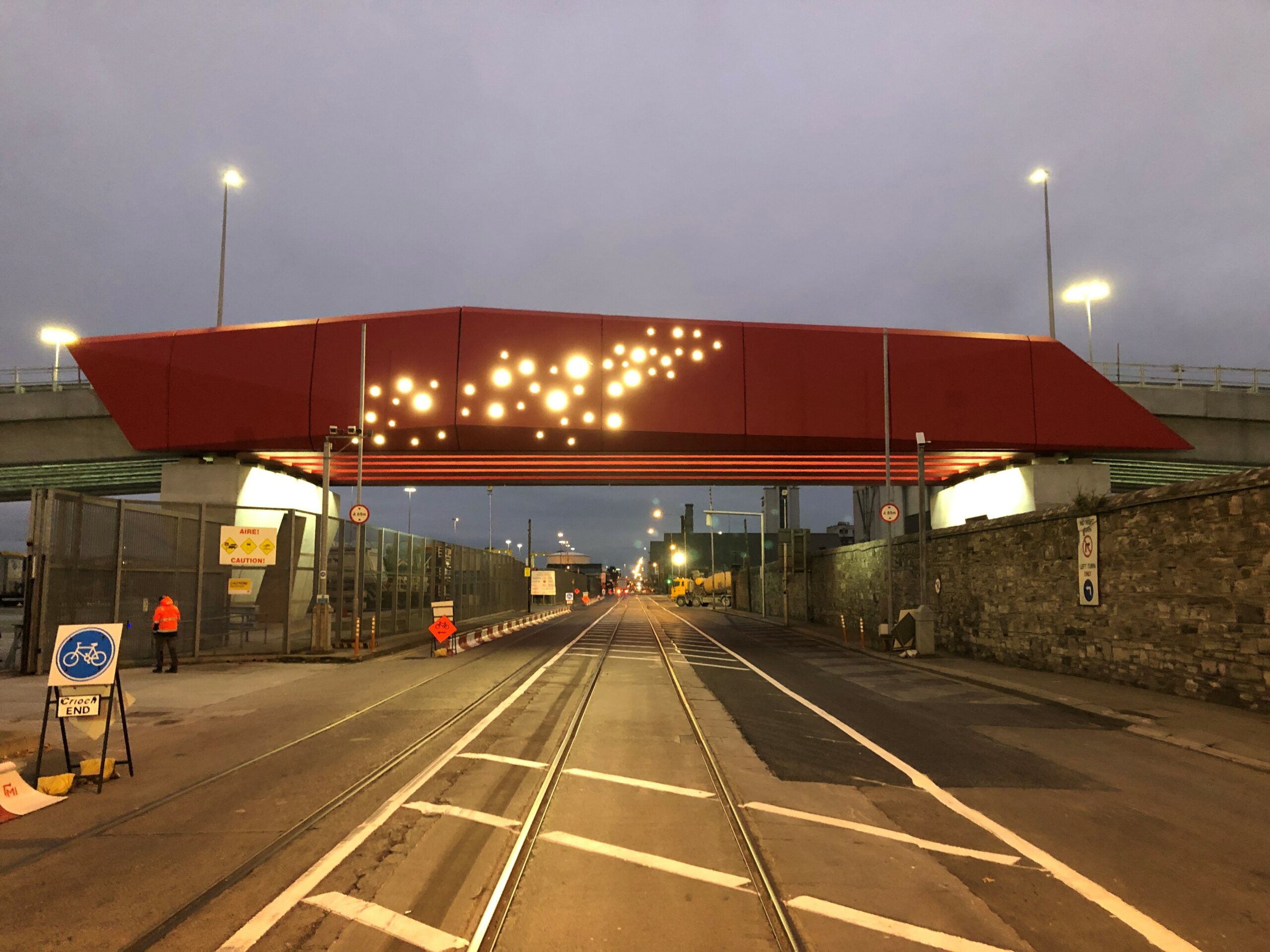
Constructed by John Sisk & Son and provides a continuous flow of freight between Terminal 4-yard areas at Dublin Port. It was completed in November 2021.
The primary element of the project was a Red Bridge of 39 metres in length which formed part of a much larger piece of infrastructure enabling the movement of Ro Ro from the southern side of the Alexandra Road to the Northern side over live Railway and Road infrastructure set within the Dublin Port Facility. The engineering challenge was significant, designing and constructing a bridge which will be installed over a live railway line and critical road infrastructure.
The Red Bridge concept extended to all elements of the bridge including the top surface which was provided by way a pigmented pavement finish. The Contractors Design Challenge: The contractor designed element provided a significant challenge from both the structural design and construction viewpoints. The original concept for the façade was detailed in Glass Reinforced Concrete (GRC). The panels are five metres wide with the tallest panel being 4.9 metres in height. The geometry varies on each panel with up to four outer planes on some panels. There are eight sections to the façade on each side with the overall length of each side being 39 metres. The three centre panels on each side have 44 circular openings varying in diameter from 100mm to 600mm with each one containing an LED star light.
Architecture
Darmody Architecture in conjunction with DBFL Consulting Engineers were retained by Dublin Port Company Ltd (DPC) to design the most appropriate solution under the challenging conditions. The design response conceived a modern intervention which would achieve the functional aspects of the client brief and equally important was the generation of a visual gateway into the greater Dublin Port facilities.
It was inspired by the Poolbeg Lighthouse which robustly marks the entrance to Dublin Port and resonates fondly with all who connect with it.
Darmody Architecture liked the robust simplicity of the Poolbeg lighthouse and wanted to carry some of its characteristics into the bridge design. They had previously explored forms as part of the Port Centre project when creating the crane enclosure both in RC concrete and perforated metal Corten cladding. This experience led them to explore dynamic forms for the structural cladding which could incorporate starburst lighting as a communicator of the tidal currents. The concrete bridge beams provided an elegant, ribbed underbelly to the giant span which come to life at night with their light beam installation. The complete assemble communicates a fluid and dynamic structure which rests on just four columns on either side of the road. The shear robustness of the cladding elements designed by John Sisk & Son and cast on site provided for a masterful piece of design and construction.
Challenges
The challenges associated in constructing this façade were numerous given its difficult shape, geometry and location. The engineering involved in fixing the units to the bridge was complex and John Sisk & Son conducted detailed investigation into the viability of a reinforced concrete façade as an alternative to the GRC concept. The challenges included: Complex reinforcement design and arrangement · Size and weight (panels up to 16 tonnes each covering 25 square metres) · The large diameter circular openings · Casting of the units · Transport and handling of the units.
It was concluded that there were also numerous advantages to the reinforced concrete option for the project as opposed to GRC.
These included the provision of a robust connection detail, better impact resistance and low long-term maintenance of the structure. John Sisk & Son engaged a Civil and Structural Engineering Consultant (BFP Consulting) to carry out the detailed design of the facade. The design was essentially a 150mm thick singly reinforced panel with two ribs. The ribs provided stiffness to the slim panel while also providing anchorage for the cast ins used in the permanent fixing to the bridge structure. The Client’s Engineer, and overall bridge designer (DBFL Consulting Engineers), made some structural changes including introducing a small deck cantilever and changes to the in-situ walls on both sides of the bridge that the façade is fixed to. The process was a collaborative approach by all stakeholders.
Construction Phase
The size and geometry of the panels led the contractor to cast the 16 panels on site. The casting beds were constructed adjacent to the bridge and a match-cast system was adopted to minimise casting anomalies. The panels were cast face down with a closing shutter used to form the back and ribs. The reinforcement was primarily 8mm in diameter and was bent on site due to the complex nature of the panels.
Roadstone supplied a self-compacting concrete (SCC) that could fully encapsulate the slender formwork and achieve the high-quality finishes as specified. Through careful planning between the design team, contractor and the producer a design mix and placement methodology were agreed upon. An SCC concrete to a slump-flow class of SF2 was seen as the best option to achieve full encapsulation of the formwork and the desired quality of finish. The units were then poured in a hit and miss format. The central span of the bridge structure itself had in-situ reinforced concrete walls constructed to enable the façade panels to be fixed in position. These walls had a series of sleeves at rib positions to enable the panels to be bolted through using stainless steel fixings. The walls also had a series of openings at the three centre panel locations to enable access for maintenance of the lighting system.
Once all 16 panels were cast and cured, the process of lifting them out and placing them on the bridge began. The slim design and shape of the panels gave rise to a difficult handling process. The units were first jacked vertically on 4 corners of a steel H-frame 100mm from the bed prior to being lifted out and set into a bespoke cradle.
The cradle was then stood vertically using two cranes before being used to lift the unit into position on the bridge during a weekend road and rail closure. The external faces of the panels were then coated with a red flexible coating system before each of the 88-star lights were installed in the cast in recesses. The façade is further lit with four projectors that change in intensity depending on the tide levels in the port.
In summary, the façade on the Terminal 4 Alexandra Road Bridge is testament to how an architectural design that posed many technical and engineering challenges can be realised through collaboration with all stakeholders.
